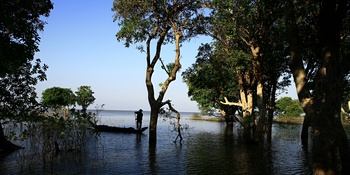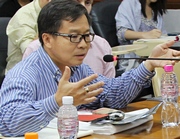
Across the Mekong Region, forests and woodlands play an important role in the lives of many people. Much of this land is used and managed by local communities, who rely on them for food, timber and other products, go fishing in nearby wetlands and streams, and draw water from the rivers for domestic use and for crops.
Economists call those arrangements “common pool resources”: large, but finite resources that are shared by a group of people, often working under a non-formal set of rules and regulations. If they are managed sustainably, the community can benefit from them indefinitely, but if some people start over-exploiting them, the resources can be depleted.
The Third International Conference on International Relations and Development, hosted by Chulalongkorn University in Bangkok on 22-23 August, drew scientists and decision-makers from across the region to discuss the challenges of shared resources, under the theme “Beyond Borders: Building a Regional Commons in Southeast Asia”. As part of the conference, SEI Asia and the Sustainable Mekong Research Network (SUMERNET) hosted a roundtable discussion titled “The Forest Commons in a Rapidly Changing Mekong”.
The event, which was chaired by Dr. Louis Lebel, a SUMERNET advisor and SEI associate, began by reflecting on the recent rapid changes in land-use, livelihoods and patterns of investment and trade in the Mekong Region that are providing a dynamic context to how forestlands are being managed.
The users of these “commons”, usually the local communities that depend on these resources for livelihoods, often have agreed-upon rules or certain prohibitions on the use of harvesting tools and methods (e.g. mesh size of fishing nets), specified seasonal uses (no mushroom collection during specific months or no fishing during the breeding season), and rules protecting against the over-harvesting of resources (eg. collection of non-timber products in certain areas).
But those rules are increasingly being contested, and there have also been conflicts over who gets to decide how forest resources are used.
Dr. Eric Kemp-Benedict, director of the SEI Asia Centre, said one source of conflict is that the definition of what is a “forest” or “forest land” varies depending on the perspective of the forestry department, ecologist and conservationists, or rural users. Forestry agencies may not realize the importance of local land-use classifications, added Dr. Pornchai Uttarak of Mahasarakham University in Thailand, who described how communities made their own classification of forest areas depending on their use such as for firewood collection, grazing or conservation.

Perspectives about forests and forest management are also changing, said Dr. Chusak Wittayapak of Chiang Mai University. While in the last few decades, the disputes over control of forested areas were mostly between the state and local people, “nowadays, forests are viewed in terms of ecosystem services. These areas are contested in terms of how to control and regulate forests with an increasing trend to introduce market-based mechanisms.”
Dr. Chusak pointed to global issues such as global climate change and natural disasters as examples of the changes in the way that forests are viewed and the terms by which access is being negotiated.
The discussion also addressed social justice issues, including aspects of women’s rights and gender issues arising from the use of forest lands. James Bampton from the Bangkok-based RECOFTC-The Center for People and Forests said that conflicts and killings of people due to land-related conflicts have been increasing over the recent years due to resource conflicts among the state, private firms and local resource users.
“Many forestry projects often end up exploiting women’s labor and time, but the women themselves may not obtain any benefits from these projects despite their increased workloads,” said Dr. Bernadette P. Resurrección of SEI-Asia.
Speakers also addressed the influence of the larger political economy, as resource management policies can often result in the unsustainable use of forest land. The “commons logic” in forest management could offer a way forward for beneficial results for forest management and ensure that people who depend on forest-based resources are also involved in its management, speakers said. If integrated as part of resource governance, forest commons could improve social and environmental outcomes in forestland management and protect and promote the interests of poor and vulnerable groups in society.
The roundtable discussion was supported by the Swedish International Development Cooperation Agency (Sida) and the Climate and Development Knowledge Network (CDKN) through SUMERNET.
Design and development by Soapbox.
